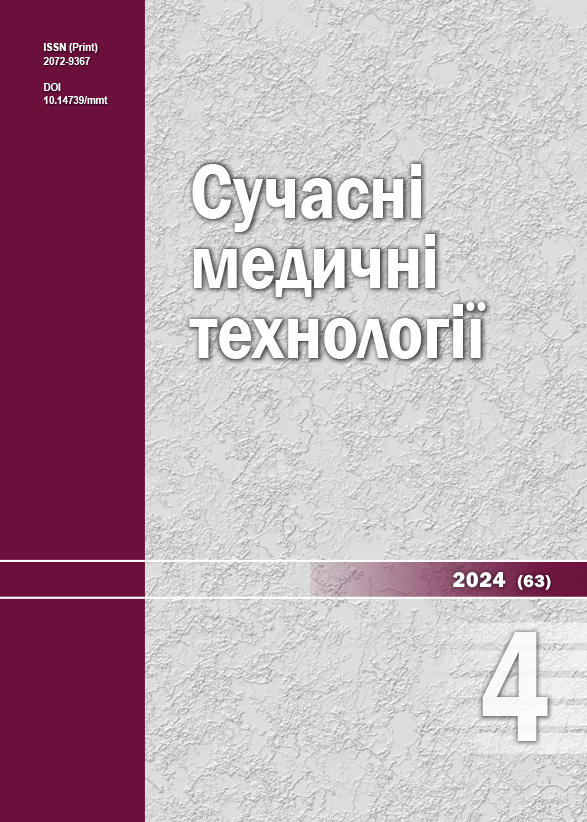Use of intraoperative luminescent methods for detecting affected lymph nodes in patients with complicated forms of colon cancer
DOI:
https://doi.org/10.14739/mmt.2024.4.307038Keywords:
colorectal cancer, diagnosis, complications, photoluminescence examination, fluorescein, lymph nodes, lymphographyAbstract
The issue of the volume of lymphatic dissection in patients with complicated forms of colon cancer and the possibility of using methods of intraoperative visualisation of the affected lymph nodes remains controversial.
The aim of the study – to analyse the results of using the intraoperative luminescent method of detecting affected lymph nodes in patients with complicated forms of malignant diseases of the large intestine.
Materials and methods. The study group included 109 patients with complicated forms of colon cancer. In the gender structure, female patients predominated – 57 (52.29 %), there were 52 (47.71 %) men. The average age of the patients was 69.78 ± 16.37 years. Contrasting of regional lymph nodes was carried out using a 10 % sodium fluorescein solution.
Results. According to the results of the fluorescence examination, in 67 (61.47 %) patients, lymph nodes were visualized in the regional lymphatic outflow: in 39 (58.21 %) cases, the visualized lymph nodes were located in the area of epi- and paracolic nodes (lymphodissection D1), in 23 (34.33 %) of patients – in the zone of mesocolic lymph nodes (lymphodissection D2) and in 5 (7.46 %) – in the zone of apical lymph nodes (3rd level of lymph drainage). A total of 268 lymph nodes were detected in 109 patients, which was an average of 2.46 lymph nodes per 1 patient. These nodes were marked and sent for histological examination separately from the main preparation. In total, a pathohistological examination of 1436 lymph nodes from the regional zone of lymph drainage from colon cancer was carried out, which was an average of 13.17 lymph nodes per 1 patient.
Conclusions. The use of a 10 % solution of sodium fluorescein as a preparation for photoluminescence examination made it possible to visualize lymph nodes in the regional lymphatic outflow zone for the tumor in 67 (61.47 %) patients. The use of photoluminescence made it possible to determine the optimal volumes of lymphatic dissection without unjustified expansion in the case of surgical interventions for complicated forms of colon cancer. The levels of sensitivity and specificity of the photoluminescent method of detecting affected lymph nodes using a 10 % solution of sodium fluorescein had quite high results and amounted to 72.41 % and 93.28 %, respectively.
References
Ukrainian cancer registry statistics. [Cancer in Ukraine, 2018-2019. Occupation, death, demonstration of oncological service]. Bulletin of National Cancer Registry of Ukraine. 2020;21. Ukrainian. Available from: http://www.ncru.inf.ua/publications/BULL_21/index.htm
Sung H, Ferlay J, Siegel RL, Laversanne M, Soerjomataram I, Jemal A, et al. Global Cancer Statistics 2020: GLOBOCAN Estimates of Incidence and Mortality Worldwide for 36 Cancers in 185 Countries. CA Cancer J Clin. 2021;71(3):209-49. doi: https://doi.org/10.3322/caac.21660
Biondo S, Gálvez A, Ramírez E, Frago R, Kreisler E. Emergency surgery for obstructing and perforated colon cancer: patterns of recurrence and prognostic factors. Tech Coloproctol. 2019;23(12):1141-61. doi: https://doi.org/10.1007/s10151-019-02110-x
Chen K, Wang H, Collins G, Hollands E, Law IY, Toh JW. Current Perspectives on the Importance of Pathological Features in Prognostication and Guidance of Adjuvant Chemotherapy in Colon Cancer. Curr Oncol. 2022;29(3):1370-89. doi: https://doi.org/10.3390/curroncol29030116
Yang KM, Jeong MJ, Yoon KH, Jung YT, Kwak JY. Oncologic outcome of colon cancer with perforation and obstruction. BMC Gastroenterol. 2022;22(1):247. doi: https://doi.org/10.1186/s12876-022-02319-5
Li N, Lu B, Luo C, Cai J, Lu M, Zhang Y, et al. Incidence, mortality, survival, risk factor and screening of colorectal cancer: A comparison among China, Europe, and northern America. Cancer Lett. 2021;522:255-68. doi: https://doi.org/10.1016/j.canlet.2021.09.034
Kubrak MA, Zavhorodnii SM, Danyliuk MB. [Problems of staging complicated forms of colon carcinoma in patients operated on urgently in a general surgical hospital]. Pathologia. 2023;20(1):45-9. Ukrainian. doi: https://doi.org/10.14739/2310-1237.2023.1.273868
Baddam DO, Ragi SD, Tsang SH, Ngo WK. Ophthalmic fluorescein angiography. In: Methods in Molecular Biology. New York, NY: Springer US; 2023. p. 153-60. doi: https://doi.org/10.1007/978-1-0716-2651-1_15
Kerschbaumer J, Demetz M, Krigers A, Pinggera D, Spinello A, Thomé C, et al. Mind the gap-the use of sodium fluoresceine for resection of brain metastases to improve the resection rate. Acta Neurochir (Wien). 2023;165(1):225-30. doi: https://doi.org/10.1007/s00701-022-05417-1
Ma S, Kim JH, Chen W, Li L, Lee J, Xue J, et al. Cancer Cell-Specific Fluorescent Prodrug Delivery Platforms. Adv Sci (Weinh). 2023;10(16):e2207768. doi: https://doi.org/10.1002/advs.202207768
Mieog JS, Achterberg FB, Zlitni A, Hutteman M, Burggraaf J, Swijnenburg RJ, et al. Fundamentals and developments in fluorescence-guided cancer surgery. Nat Rev Clin Oncol. 2022;19(1):9-22. doi: https://doi.org/10.1038/s41571-021-00548-3
Zhang Z, Du Y, Shi X, Wang K, Qu Q, Liang Q, et al. NIR-II light in clinical oncology: opportunities and challenges. Nat Rev Clin Oncol. 2024;21(6):449-67. doi: https://doi.org/10.1038/s41571-024-00892-0
Tazawa H, Shigeyasu K, Noma K, Kagawa S, Sakurai F, Mizuguchi H, et al. Tumor-targeted fluorescence labeling systems for cancer diagnosis and treatment. Cancer Sci. 2022;113(6):1919-29. doi: https://doi.org/10.1111/cas.15369
Fujita K, Urano Y. Activity-Based Fluorescence Diagnostics for Cancer. Chem Rev. 2024;124(7):4021-78. doi: https://doi.org/10.1021/acs.chemrev.3c00612
Zhang Y, Zhang G, Zeng Z, Pu K. Activatable molecular probes for fluorescence-guided surgery, endoscopy and tissue biopsy. Chem Soc Rev. 2022;51(2):566-93. doi: https://doi.org/10.1039/d1cs00525a
Dan AG, Saha S, Monson KM, Wiese D, Schochet E, Barber KR, et al. 1% lymphazurin vs 10% fluorescein for sentinel node mapping in colorectal tumors. Arch Surg. 2004;139(11):1180-4. doi: https://doi.org/10.1001/archsurg.139.11.1180
Downloads
Additional Files
Published
How to Cite
Issue
Section
License
The work is provided under the terms of the Public Offer and of Creative Commons Attribution-NonCommercial 4.0 International (CC BY-NC 4.0). This license allows an unlimited number of persons to reproduce and share the Licensed Material in all media and formats. Any use of the Licensed Material shall contain an identification of its Creator(s) and must be for non-commercial purposes only.














